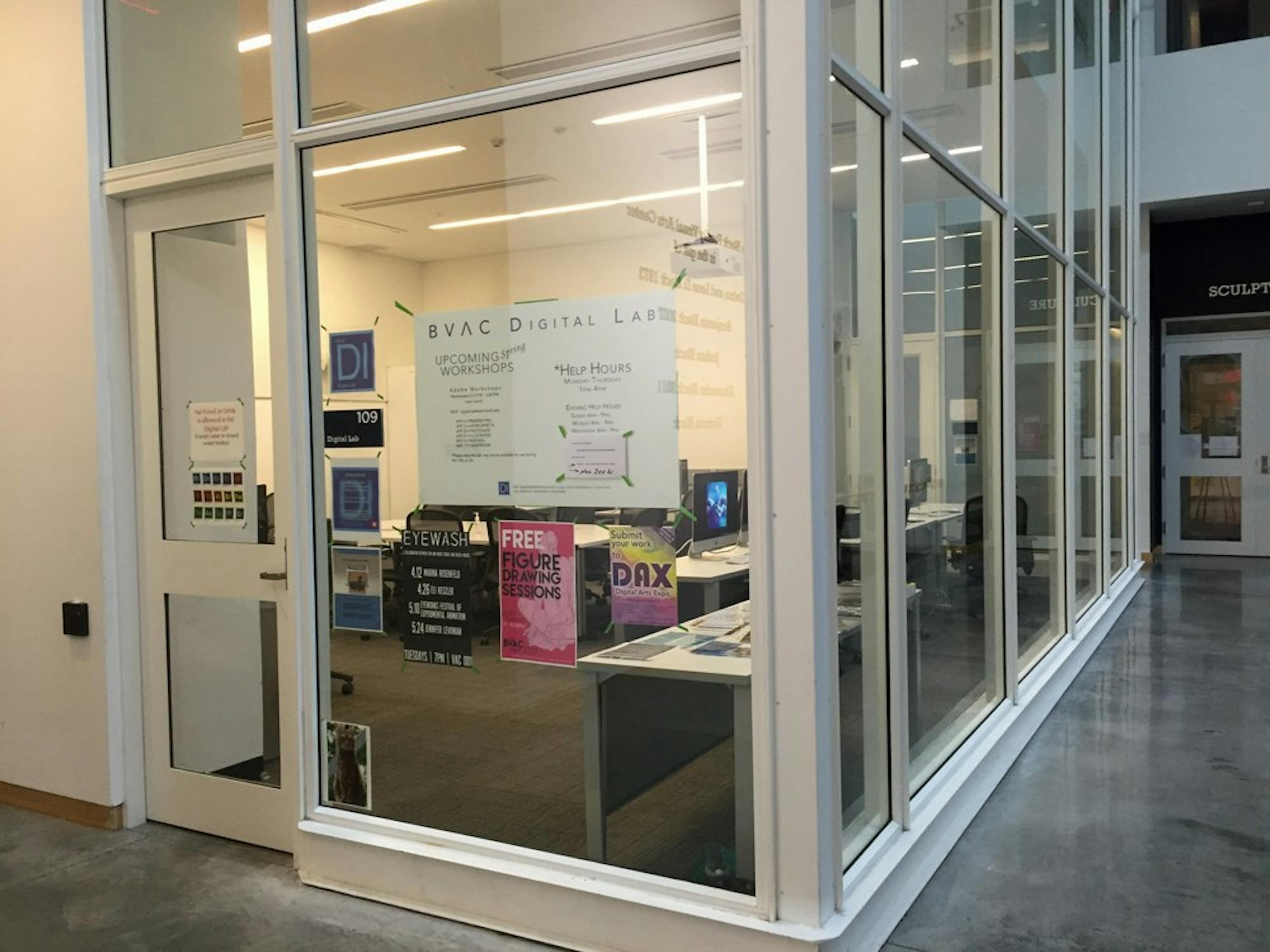Surrounded by glass walls, the digital arts lab can be found in the middle of the first floor of the Black Family Visual Arts Center. The lab is a space in which students can create digital art using some of the most powerful graphic design and video editing software available today.
“I recommend anyone who wants to learn how to edit film, make a poster — just any creative thing they have in mind — that’s the best digital resource that Dartmouth has for that sort of stuff,” Matt Rossi ’16 said.
The digital lab houses 11 computers in a multi-use room that is currently set up for seminar classes and workshops, as well as lectures. The most commonly-used software package available in the lab is Adobe Creative Cloud, a collection of software that includes After Effects, Photoshop and Premiere Pro.
Chris Ivanyi, the digital lab specialist, envisions the lab becoming a vibrant space in which all members of the Dartmouth community can experiment with and learn about different digital arts software.
“It’s always my hope that it becomes this third space — home, work and this place — where people can come in and just create cool things with the tools that we have,” Ivanyi said.
Several classes have been held in the lab, including professor Karolina Kawiaka’s Studio Art 17 “Digital Drawing” class, as well as professor Jeffrey Ruoff’s Film Studies 36 “Experimental Filmmaking” class.
Only through key card access can studio art and film and media studies majors access the lab, but Ivanyi allows any student who wants to learn about the software or work on a project to use the lab.
“I have this open door policy,” Ivanyi said. “If someone has a particular project they want to work on, with or without my help, they can come back anytime.”
Rossi also noted how Ivanyi welcomes all students to the space.
“If Chris knows that you’re pretty passionate about what you’re doing, and you ask him, he’s very laid back about it,” he said.
In order to make the lab and the technology more accessible to students, Ivanyi also organizes and holds weekly workshops that allow students to learn about and experiment with different software. These workshops are designed to cater both to people who are already familiar with the software and those who have never touched the programs.
“People can get a little bit of a hands-on and not be so intimidated,” Ivanyi said. “Some folks already know this stuff already, but we have a lot of people come through who haven’t even touched Illustrator or Photoshop.”
Ivanyi holds make-up workshops on Friday afternoons for people who missed them earlier in the week. In addition to workshops, Ivanyi invites professors from other departments to dicuss how they use software in their courses. Last term, Ivanyi invited guest artists, including local filmmakers and computer science professor Patricia Hannaway who teaches animation courses, to demonstrate their use of the digital programs.
Although Rossi has not taken a class that required the use of the digital lab, he has used the lab for several personal projects.
“Chris was really welcoming,” Rossi said. “I basically told him what I wanted to do, and he got me started on Premiere Pro.”
He recalled that after getting an introduction through Ivanyi, he was able to move on to more complicated techniques, such as “color correcting.”
Kyle Kaplan, a second year masters student in digital musics, also found the lab’s software and hardware to be invaluable resources.
“The computers are many times faster than what I personally would have access to with my own laptop,” he said.
Rossi also appreciated that Ivanyi himself constantly learns as he teaches students about the software, making the interaction more like a conversation than a lecture.
“The environment feels less like a lecture world, where all this information is being thrown at you,” Rossi said. “It’s more like a collaboration between whoever is working there and Chris.”
For his first project using the lab, Rossi edited video footage he took with a drone flying over Dartmouth’s campus. He is currently filming a few short films as part of another personal project and plans on returning to the lab to edit his footage.
Kaplan also noted that besides Ivanyi, other students working in the lab are available to provide help.
“There’s a nice sense of community that it creates because you’re just in contact with people who are also doing creative video work,” Kaplan said. “There’s a nice camaraderie that gets fostered in the digital lab.”
Most of the video editing for two of Kaplan’s personal projects took place in the digital lab. One of the projects, an eponymous documentary on the Taiwanese noise musician, Dino, featured an extended interview interspersed with performance footage.
“[Dino] is a very compelling person, with punk rock roots that led to noise music from Taiwan’s huge cultural revolution during the ’90s right after the democratization of Taiwan,” Kaplan said. “Western influence, and with it noise music, started to penetrate the culture. He was the product of that.”
After attending Ivanyi’s workshop for After Effects and Premiere Pro, Kaplan sought to explore Premiere Pro as in depth as possible for his Dino project.
Ivanyi acknowledged that being the sole person running the digital lab can be a lot of work, but the benefits are greater.
“There’s nothing more rewarding than to have a student come in who has never worked on this and create something amazing,” Ivanyi said.




